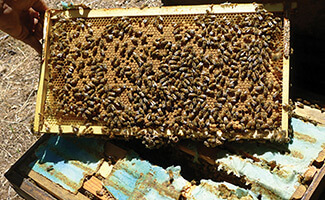
There has been a huge amount of interest in the extended-release application of oxalic acid for controlling varroa. I and my collaborators have been working hard to collect the data necessary get this treatment approved for use by U.S. beekeepers. We’ve still got lots to learn, but here’s an update.
Disclaimer and legality: The information in this article is solely to report on my beekeeper-funded progress (working in conjunction with ARS and others) towards getting this application method approved by EPA, and is not intended to promote illegal use in any way. I neither approve of, nor encourage, applications not sanctioned by local authorities.[1] This is not a “how to”—please do not write me asking how to apply it yourself until we have got the bugs worked out and gotten it registered.
This application method of oxalic acid dissolved in glycerin (OA/gly) approved by EPA, we need to submit data to support its efficacy, lack of adverse effects upon the bee colony, and safety to the beekeeper/applicator and the honey consumer. To that end, myself, Jennifer Berry, and Drs. Jay Evans, Geoff Williams, and Meghan Milbrath are collecting data by performing controlled field trials in California (low humidity), Georgia (high humidity), Beltsville Maryland, and northerly Michigan.
Objectives:
The objectives of these experiments are to test various application methods over 42 days (two honey bee brood cycles; roughly 2.5 varroa reproductive cycles) for:
Efficacy: To determine the efficacy of the treatment method at reducing the in-hive varroa infestation, compared to a solvent control (a towel with glycerin only), and a sham treatment (a towel only).[2]
Adverse effects: To determine whether there are measureable or observable adverse effects upon the bee colony from treatment with oxalic/glycerin.
Residues in honey: To determine whether treatment results in elevation of the naturally-occurring levels of oxalic acid in harvestable honey.
The above are abbreviated snips from the detailed protocols that we developed, based upon the minimal research that I had done up to actually initiating the trials (we’ve made last-minute changes all summer as we learn new things). For the California trial, I equalized 64 hives, entrances facing different directions, took mite washes from all, ranked them by starting mite count, and systematically assigned treatments so that each treatment was applied equally to the full range of mite infestation rates.[3] I set up the trial in my home yard, just at the beginning of what I expected would be a normal honey flow (Fig. 1).
I then inspected two frames of brood from each hive for adverse effects (and to check for queen rightness), and then shook a sample of bees for mite washing (Fig. 5).
But we weren’t done yet—we still needed to take samples of freshly-stored honey to be processed at Beltsville to determine their oxalic acid content (Fig. 6).
Initial results
I’ve only analyzed the data to date for the California trial, but unfortunately can’t publish it here, since it is going to be included in a peer-reviewed scientific publication. Suffice to say that there were absolutely no observable effects from treatment on colony strength or weight gain (which was minimal, due to a heat wave knocking out our honey flow). Nor did I observe any adverse effects upon colony health or the brood pattern.
Efficacy at Reducing the Mite Level
The oxalic treatment reduced the rate of mite buildup by the midpoint grading, and by the end point (at 48 days) resulted in 94% efficacy at reducing the median mite count.[5] The mite count dropped nicely in 23 out of 24 hives, but surprisingly, skyrocketed in a single treated hive.[6]
Informal Testing in California
We had also informally treated several yards of of hives early in the season[7], giving each hive a single full OA shop towel, and are currently checking mite counts—in some yards, the single treatment held mite counts to surprisingly low levels (a number with zeros and ones), but in other yards the treatment only reduced the expected climb–but the reduction was generally substantial. Of note is that in our August inspections of those OA-treated hives (all with 2nd year queens), they were some of the best-looking hives in our operation.
Practical application: as did Maggi[8], we’ve clearly demonstrated proof of concept—that a single extended-release oxalic acid treatment can bring mite counts down to close to zero, without any apparent adverse side effects to the colony. But applied as above, the results may be inconsistent—the method still needs fine-tuning for improvement.
An Important Finding
Of greatest interest to me were the hive-to-hive differences in the amounts of the towels removed by the bees. The bees removed the dry (sham) towels in about a day, and the glycerin-alone towels within a few days. But there was wide variation in how they ….


